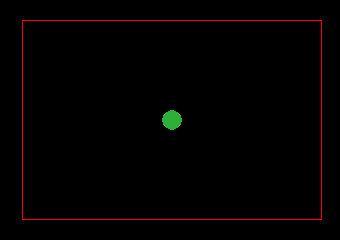How to make ball bounce off wall with PyGame?
Before you criticize me for not Googling or doing research before asking, I did research beforehand but to no avail.
I am trying to create the Atari Breakout game. I am currently stuck with making the ball bounce off walls. I did research on this and I found a lot of blogs and YouTube videos (and also Stack Overflow questions: this and this) talking about PyGame's vector2 class. I also read the PyGame documentation on vector2 but I can't figure out how to make it work.
I am currently writing a script to make the ball bounce off walls. In the beginning, the player is requested to press the spacebar and the ball will automatically move towards the north-east direction. It should bounce off the top wall when it hits it, but instead, it went inside. This is my approach:
import pygame
pygame.init()
screenWidth = 1200
screenHeight = 700
window = pygame.display.set_mode((screenWidth,screenHeight))
pygame.display.set_caption('Atari Breakout')
class Circle():
def __init__(self, x, y, radius):
self.x = x
self.y = y
self.radius = radius
self.vel_x = 1
self.vel_y = 1
def check_hit():
global hit
if (((screenWidth-box.x)<=box.radius) or ((box.x)<=box.radius) or ((box.y)<=box.radius) or ((screenHeight-box.y)<=box.radius)):
# meaning hit either four walls
if (((screenWidth-box.x)<=box.radius) or ((box.x)<=box.radius)):
# hit right, left
print('hit right, left')
hit = True
elif (((box.y)<=box.radius) or ((screenHeight-box.y)<=box.radius)):
# hit top, bottom
print('hit top, bottom')
hit = True
# main loop
run = True
box = Circle(600,300,10)
hit = False
# (screenWidth-box.x)<=box.radius hit right wall
while run: # (box.x)<=box.radius hit left wall
# (box.y)<=box.radius hit top wall
pygame.time.Clock().tick(60) # (screenHeight-box.y)<=box.radius hit bottom wall
for event in pygame.event.get():
if event == pygame.QUIT:
run = False
keys = pygame.key.get_pressed()
if keys[pygame.K_SPACE] and (box.y)>box.radius:
while True:
box.y -= box.vel_y
box.x += box.vel_x
window.fill((0,0,0))
pygame.draw.circle(window, (44,176,55), (box.x, box.y), box.radius)
pygame.display.update()
check_hit()
if hit == False:
continue
elif hit == True:
break
if (box.y)<=box.radius or (screenHeight-box.y)<=box.radius:
# hit top, bottom
box.vel_x *= 1
box.vel_y *= -1
print('changed')
if (box.y)<=box.radius:
# hit top
print('hi')
while True:
box.x += box.vel_x # <-- myguess is this is the problem
box.y += box.vel_y
window.fill((0,0,0))
pygame.draw.circle(window, (44,176,55), (box.x, box.y), box.radius)
pygame.display.update()
elif (screenWidth-box.x)<=box.radius or (box.x)<=box.radius:
# hit right, left
box.vel_x *= -1
box.vel_y *= 1
window.fill((0,0,0))
pygame.draw.circle(window, (44,176,55), (box.x, box.y), box.radius)
pygame.display.update()
print('Where are you going')
pygame.quit()
I guess the problem is where I marked. Which is here:
if (box.y)<=box.radius or (screenHeight-box.y)<=box.radius:
# hit top, bottom
box.vel_x *= 1
box.vel_y *= -1
print('changed')
if (box.y)<=box.radius:
# hit top
print('hi')
while True:
box.x += box.vel_x # <-- myguess is this is the problem
box.y += box.vel_y
window.fill((0,0,0))
pygame.draw.circle(window, (44,176,55), (box.x, box.y), box.radius)
pygame.display.update()
but I don't know why. My theory is: the ball travels upwards, it hit the top wall, check_hit() kicks in and make hit = True, then the vel_x and vel_y is changed accordingly (if hit top wall, vel_x should remain the same while vel_y should be multiplied by -1). Then it will move down, hence "bounce" off the top wall.
Note: for now I only have the top wall working. The other three will be done when I can figure out how to bounce off the top wall first.
Can you help me see what's the problem? And if this kind of operation requires the use of the vector2 class, can you explain it to me or give me a place to learn it?
Solution 1:
The issue are the multiple nested loops. You have an application loop, so use it.
Continuously move the ball in the loop:
box.y -= box.vel_y
box.x += box.vel_x
Define a rectangular region for the ball by a pygame.Rect object:
bounds = window.get_rect() # full screen
or
bounds = pygame.Rect(450, 200, 300, 200) # rectangular region
Change the direction of movement when the ball hits the bounds:
if box.x - box.radius < bounds.left or box.x + box.radius > bounds.right:
box.vel_x *= -1
if box.y - box.radius < bounds.top or box.y + box.radius > bounds.bottom:
box.vel_y *= -1
See the example:

box = Circle(600,300,10)
run = True
start = False
clock = pygame.time.Clock()
while run:
clock.tick(120)
for event in pygame.event.get():
if event.type == pygame.QUIT:
run = False
keys = pygame.key.get_pressed()
if keys[pygame.K_SPACE]:
start = True
bounds = pygame.Rect(450, 200, 300, 200)
if start:
box.y -= box.vel_y
box.x += box.vel_x
if box.x - box.radius < bounds.left or box.x + box.radius > bounds.right:
box.vel_x *= -1
if box.y - box.radius < bounds.top or box.y + box.radius > bounds.bottom:
box.vel_y *= -1
window.fill((0,0,0))
pygame.draw.rect(window, (255, 0, 0), bounds, 1)
pygame.draw.circle(window, (44,176,55), (box.x, box.y), box.radius)
pygame.display.update()